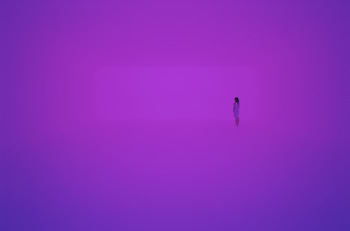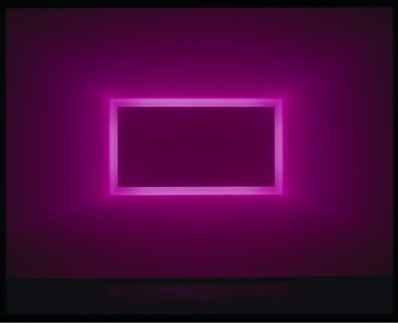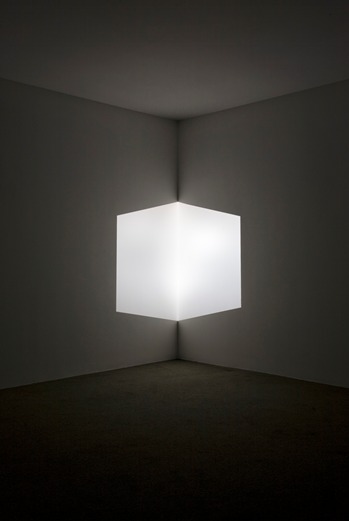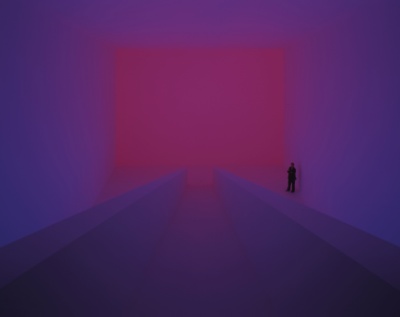In May, while the finishing touches were being made to James Turrell: A Retrospective, 13 students from local colleges and universities were studying Turrell’s work and learning about strategies for engaging with visitors to the exhibition. Over the course of 14 Saturdays, from June 1 through August 31, these students conversed with members of the public while exploring the exhibition. As their time working with the exhibition came to a close, we spoke with some of the students about what they have learned and observed over the summer, as well as tips they have for people who have not yet visited the exhibition. Here is part one of their reflections.
 James Turrell, Breathing Light, 2013, LED light into space, Los Angeles County Museum of Art, purchased with funds provided by Kayne Griffin Corcoran and the Kayne Foundation, M.2013.1, © James Turrell, Photo © Florian Holzherr
James Turrell, Breathing Light, 2013, LED light into space, Los Angeles County Museum of Art, purchased with funds provided by Kayne Griffin Corcoran and the Kayne Foundation, M.2013.1, © James Turrell, Photo © Florian Holzherr
LACMA: What has been the most interesting thing you have learned about Turrell’s work this summer?
Aida Lugo (recent graduate, Otis College of Art and Design): The most interesting thing I learned about Turrell’s work was the inquisition this work creates in those who view it. After viewing a work the audience is full of wonder. It is interesting to me the questions Turrell frames for the viewer: how is art like science, archaeology, architecture, and psychology? What happens to our perception when we enter a space, light or complete darkness?
Kristen Laciste (senior, UCLA): What I found most interesting about James Turrell’s oeuvre is that his experiences (such as the notion of greeting the “inner light” associated with his Quaker upbringing and his childhood activity of poking holes in the window covers to see light shine through) influenced his fidelity to the exploration of light.
 James Turrell, Raemar Pink White, 1969, Shallow Space, collection of Kayne Griffin Corcoran, Los Angeles, installation view at Griffin Contemporary, Santa Monica, California, 2004, © James Turrell, photo by Robert Wedemeyer, courtesy Kayne Griffin Corcoran, Los Angeles
James Turrell, Raemar Pink White, 1969, Shallow Space, collection of Kayne Griffin Corcoran, Los Angeles, installation view at Griffin Contemporary, Santa Monica, California, 2004, © James Turrell, photo by Robert Wedemeyer, courtesy Kayne Griffin Corcoran, Los Angeles
Marissa Clifford (senior, UCLA): One memorable moment came when my colleague Emilie and I spoke with a family of Quakers who frequented contemporary-art exhibitions. For them, Turrell’s work truly fulfills their religious tenet of “being with the light.” Just as it was for Catholics in the Baroque period, contemporary art was a way for this Quaker family to enrich their religious practice. It was inspiring to meet international visitors, from all walks of life, all of whom were captivated by the exhibition.
Kristen: As an art/art history student, it is interesting for me to know about the experiences and inspiration behind an artist’s work. This exhibition made me think about the nature of light and its use and treatment by artists through history. In art history, light is usually used as a device that illuminates, highlights, and creates depth. Light is ubiquitous, yet most people do not pay much attention to it. Turrell’s works fascinate me because they focus on light, commanding viewers to see and think about its complexities: its ability to reveal yet blind, its objectness, its intangibility, its natural and artificial properties, and its ability to shape and be shaped by spaces.
 James Turrell, Afrum (White), 1966, Cross Corner Projection, LACMA, partial gift of Marc and Andrea Glimcher in honor of the appointment of Michael Govan as CEO and Wallis Annenberg Director and purchased with funds provided by David Bohnett and Tom Gregory through the 2008 Collectors Committee, © James Turrell, photo © 2013 Museum Associates LACMA
James Turrell, Afrum (White), 1966, Cross Corner Projection, LACMA, partial gift of Marc and Andrea Glimcher in honor of the appointment of Michael Govan as CEO and Wallis Annenberg Director and purchased with funds provided by David Bohnett and Tom Gregory through the 2008 Collectors Committee, © James Turrell, photo © 2013 Museum Associates LACMA
Marissa: The idea that daily realities of our natural world that do not have tangible form could be shaped and molded into personal experience was energizing and novel to many visitors, as it is to me.
Aida: I see art as all encompassing. I feel that it is possible for an artist to have freedom from context. James Turrell dives into psychology, perception, public engagement, performance, engineering, and aviation in his work. He is a good example of an artist whose practice is based on different intellectual interests. Leading the discussions in the gallery, I found people attracted to the work, and the mysterious quality of the work was an interesting entry point for exploration. Turrell’s work succeeds in opening minds, allowing the opportunity to discover new things about our presence on Earth.
 James Turrell, Bridget’s Bardo, 2009, Ganzfeld, installation view at Kunstmuseum Wolfsburg, Germany, 2009, © James Turrell, photo © Florian Holzherr
James Turrell, Bridget’s Bardo, 2009, Ganzfeld, installation view at Kunstmuseum Wolfsburg, Germany, 2009, © James Turrell, photo © Florian Holzherr
Elizabeth Gerber, Education and Public Programs



